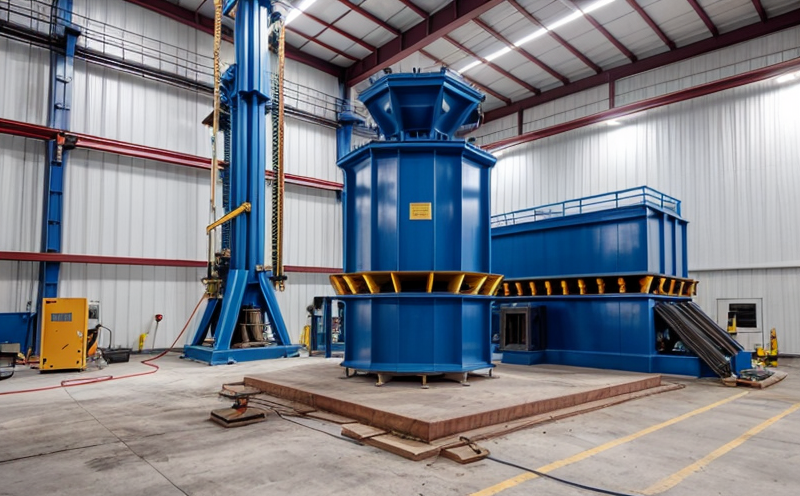ASTM C215 Resonant Frequency Testing of Concrete Structures
The ASTM C215 standard provides a method to determine the resonant frequency, flexural modulus of elasticity, and elastic modulus of concrete structures. This non-destructive testing technique is widely used in quality assurance and research applications involving structural integrity assessment.
The procedure involves exciting a specimen with an impact hammer at a specific frequency and measuring the natural vibration response using accelerometers attached to the structure's surface. The resonant frequency can then be calculated from these measurements, allowing for the determination of material properties such as flexural modulus of elasticity and elastic modulus.
This method is particularly useful in evaluating the integrity of large concrete structures like bridges, buildings, and dams where destructive testing would not only be impractical but also potentially harmful to the structure. The ASTM C215 test offers a cost-effective and non-destructive alternative for assessing structural health.
The significance of this testing lies in its ability to identify early signs of damage or deterioration before they lead to more serious issues. By detecting changes in resonant frequency, engineers can pinpoint areas requiring further investigation or maintenance. This approach also ensures compliance with international standards set by organizations such as ASTM and EN (European Norm).
The accuracy and reliability of the results obtained from this test are paramount for ensuring structural integrity. Factors affecting the outcome include proper specimen preparation, correct placement of accelerometers, environmental conditions during testing, and calibration of equipment.
For accurate results, specimens should be prepared according to ASTM C215 specifications, which involve cleaning, drying, and marking the surface before attaching accelerometers. The position of these sensors is critical as it influences the accuracy of frequency measurement. Environmental factors such as temperature and humidity must also be controlled during testing.
Calibration of equipment is another crucial aspect; any deviation from specified values could lead to erroneous results. Regular calibration checks ensure that instruments are functioning correctly throughout the testing process.
| Standard Name | Year Published | Publisher |
|---|---|---|
| ASTM C215-18a | 2018 | American Society for Testing and Materials |
| EN 12370:2019 | 2019 | European Committee for Standardization |
The above table highlights the most recent versions of applicable standards. Compliance with these guidelines ensures consistent and reliable testing results.
To summarize, ASTM C215 resonant frequency testing provides a robust method for evaluating concrete structures without causing damage. It is essential for maintaining high-quality construction practices and ensuring safety in various sectors including transportation infrastructure, industrial facilities, and residential buildings.
Why It Matters
The importance of ASTM C215 resonant frequency testing cannot be overstated given its role in safeguarding public safety and environmental sustainability. Structural integrity is critical for maintaining the longevity and reliability of concrete structures used across numerous industries. Failure to ensure proper maintenance can result in significant financial losses due to premature replacement, as well as potential hazards associated with structural collapse.
In terms of cost-effectiveness, non-destructive testing techniques like ASTM C215 offer substantial savings compared to traditional destructive methods. By identifying issues early on, costly repairs or replacements are avoided, thereby extending the life span of existing structures. This not only reduces maintenance costs but also helps in resource conservation by minimizing waste generation during construction and repair processes.
From an environmental perspective, preserving concrete structures through regular inspections prevents unnecessary demolition activities which contribute to landfill waste. Furthermore, it supports sustainable development goals by promoting efficient use of resources while enhancing resilience against natural disasters such as earthquakes or floods.
The application of ASTM C215 resonant frequency testing extends beyond mere compliance with regulations; it plays a pivotal role in advancing the state-of-the-art knowledge base regarding concrete behavior under dynamic loading conditions. Continuous improvement efforts driven by this testing methodology contribute towards developing more resilient and sustainable construction materials.
Applied Standards
The ASTM C215 resonant frequency test is guided by several key standards that define its procedures, requirements, and interpretations:
| Standard Name | Year Published | Publisher |
|---|---|---|
| ASTM C215-18a | 2018 | American Society for Testing and Materials |
| EN 12370:2019 | 2019 | European Committee for Standardization |
The above table lists the most current versions of these standards. Adherence to these guidelines ensures consistency and reliability in testing procedures.
International Acceptance and Recognition
The ASTM C215 resonant frequency test has gained widespread acceptance internationally, recognized by numerous organizations and governments worldwide due to its effectiveness in assessing the structural integrity of concrete structures. Its application spans multiple sectors including civil engineering, architectural design, transportation infrastructure, industrial facilities, residential buildings, and more.
Many countries have incorporated ASTM C215 into their national codes and standards for evaluating concrete structures. For instance, the United States Federal Highway Administration (FHWA) recommends this method for testing highway structures to ensure compliance with federal regulations. Similarly, European Union directives require member states to adopt non-destructive evaluation techniques like resonant frequency testing when inspecting public works projects.
Other notable organizations that endorse ASTM C215 include the International Organization for Standardization (ISO), which has referenced its provisions in ISO 9001 quality management systems. The American Concrete Institute (ACI) also recommends this test as part of their guidelines for concrete testing and evaluation.
The global acceptance of ASTM C215 underscores its significance in the field of structural health monitoring. As more countries adopt these practices, it becomes increasingly important to stay updated on the latest developments within the industry to ensure continued compliance with international standards.





